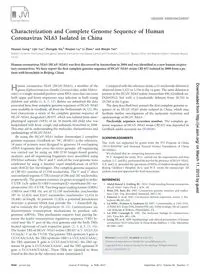
2012 Characterization and Complete Genome Sequence of Human Coronavirus NL63 Isolated in China PDF
Preview 2012 Characterization and Complete Genome Sequence of Human Coronavirus NL63 Isolated in China
Characterization and Complete Genome Sequence of Human Coronavirus NL63 Isolated in China Heyuan Geng,a Lijin Cui,a Zhengde Xie,b Roujian Lu,a Li Zhao,a and Wenjie Tana Biotech Center for Viral Disease Emergency, National Institute for Viral Disease Control and Prevention, China CDC, Beijing, China,a and Beijing Children’s Hospital, Beijing, Chinab Human coronavirus NL63 (HCoV-NL63) was first discovered in Amsterdam in 2004 and was identified as a new human respira- tory coronavirus. We here report the first complete genome sequence of HCoV-NL63 strain CBJ 037 isolated in 2008 from a pa- tient with bronchitis in Beijing, China. H uman coronavirus NL63 (HCoV-NL63), a member of the genus Alphacoronavirus (family Coronaviridae, order Nidovi- rales), is a single-stranded positive-sense RNA virus that can cause both upper and lower respiratory tract infection in both young children and adults (1, 6, 7, 13). Before we submitted the data presented here, four complete genome sequences of HCoV-NL63 were available in GenBank, all from the Netherlands (8, 12). We here characterize a strain of the complete genome sequence of HCoV-NL63, designated CBJ 037, which was isolated from naso- pharyngeal aspirate (NPA) of an 18-month-old child who was hospitalized with fever, cough, and asthmatic bronchitis in 2008. This may aid in understanding the molecular characteristics and epidemiology of HCoV-NL63. By using the HCoV-NL63 isolate Amsterdam I complete genome sequence (GenBank no. NC_005831) as the reference, 18 pairs of primers were designed to generate 18 overlapping cDNA fragments that cover the entire genome. All sequencing was carried out by using an ABI 3730 Sanger-based genetic analyzer, and all sequencing fragments were assembled using DNAStar software. The 5= and 3= ends of the viral genome were confirmed by using a Smarter rapid amplification of cDNA ends (RACE) kit (Invitrogen). The complete genome sequence of CBJ 037 consists of 27,538 nucleotides. The 5= and 3= short untranslated regions (UTR) consist of 286 and 287 nucleotides, respectively. The genome contains six genes arranged in order: 5=UTR-1a/b-spike(S)-ORF3-envelope(E)–membrane(M)-nu- cleoprotein (N)-3=UTR. Two long open reading frames (ORFs) (ORF1a and ORF 1b) are of 12,138 nucleotides (nucleotides 287 to 12,424) and 8,037 nucleotides (nucleotides 12,424 to 20,460) in length. At position 12,424, a potential pseudoknot structure is present which may provide the �1 frameshift sig- nal to translate the 1b polyprotein (9, 10). Coronaviruses use discontinuous transcription mechanisms to produce sub- genomic mRNAs. This mechanism requires base pairing be- tween the leader transcription regulatory sequence (TRS) lo- cated near the 5= part of the viral genome and the body TRSs located upstream of each respective genes (2, 3, 4, 5, 11, 14). The leader TRS of HCoV-NL63 isolate CBJ 037 is 5=-UCUCAA CUAAAC-3= at the 5=UTR. The putative TRS upstream S gene is UCUCAACUAA, the TRS upstream ORF3 is UUCAACUAAAC, the TRS upstream E gene is UCUCAACUAUAC, the TRS up- stream M gene is UCUAAACUAAAC, and the TRS upstream N gene is UCUAAACUAAAC. These TRSs are identical to those found in the sites in the reference strain Amsterdam I. Compared with the reference strain, a 15-nucleotide deletion is observed from 3,321 to 3,336 in the 1a gene. The same deletion is present in the HCoV-NL63 isolate Amsterdam 496 (GenBank no. DQ445912) but with a 3-nucleotide deletion from 20,783 to 20,788 in the S gene. The data described here present the first complete genome se- quence of an HCoV-NL63 strain isolated in China, which may facilitate further investigations of the molecular evolution and epidemiology of HCoV-NL63. Nucleotide sequence accession number. The complete ge- nome sequence of HCoV-NL63 strain CBJ 037 was deposited in GenBank under accession no. JX104161. ACKNOWLEDGMENTS This work was supported by grants from the 973 Program of China (2011CB504704) and National Natural Science Foundation of China (81100062). We declared that no competing interests exist. W.T. designed the study. H.G. carried out the experiments and data analysis. L.C. and R.L. performed the test for the presence of HCoV-NL63. Z.X. and L.Z. provided the specimens of NPAs of children hospitalized in Beijing Children’s Hospital. H.G. and W.T. wrote the manuscript. All authors read and approved the final manuscript. REFERENCES 1. Abdul-Rasool S, Fielding BC. 2010. Understanding human coronavirus HCoV-NL63. Open Virol. J. 4:76–84. 2. Brian DA, Baric RS. 2005. Coronavirus genome structure and replica- tion. Curr. Top. Microbiol. Immunol. 287:1–30. 3. Enjuanes L, et al. 2001. Coronavirus derived expression system. J. Bio- technol. 88:183–204. 4. Lai MMC, Perlman S, Anderson LJ. 2007. Coronaviridae, p 1305–1335. In Fields BN, Knipe DM, Howley PM (ed), Fields virology, 5th ed. Lippin- cott Williams & Wilkins, Philadelphia, PA. 5. Lai MM, Cavanagh D. 1997. The molecular biology of coronaviruses. Adv. Virus Res. 48:1–100. 6. Leung TF, et al. 2009. Epidemiology and clinical presentation of human coronavirus NL63 infections in Hong Kong children. J. Clin. Microbiol. 47:3486–3492. Received 12 June 2012 Accepted 18 June 2012 Address correspondence to Wenjie Tan,
